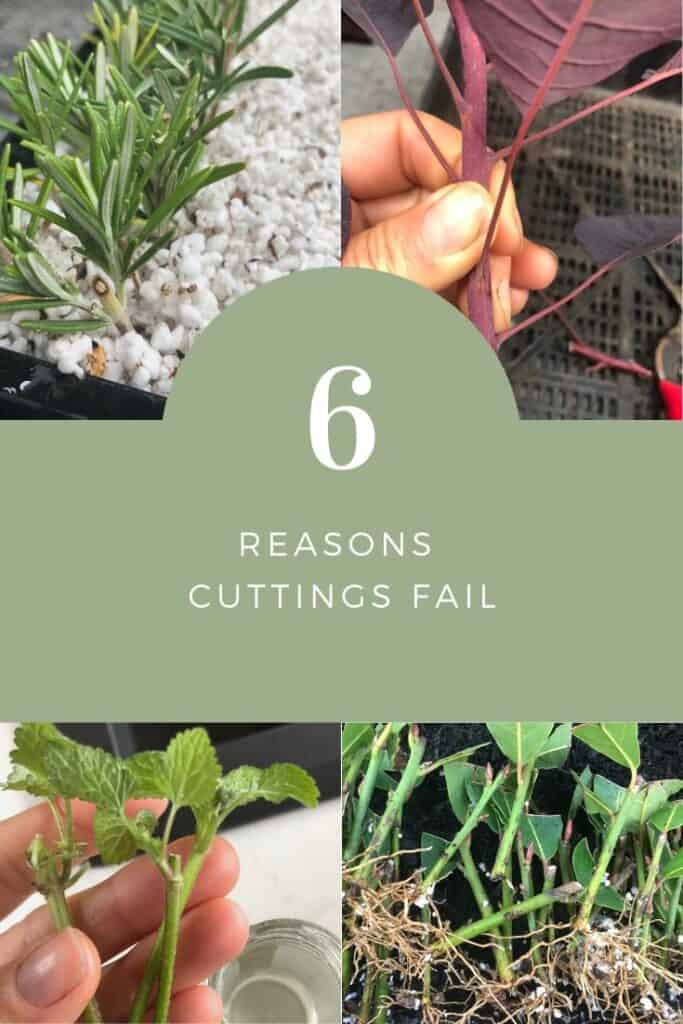Over the years propagating plants in our wholesale nursery we’ve had plenty of success. We’ve also had plenty of failures as well! Below are the 6 most common reasons your cuttings will fail.
- Wrong timing
- Using the wrong part of the stem
- Cuttings are too big
- Selecting the wrong propagation mix
- Not enough water
- Too much water
Keep reading as we explore each point in more detail.
Wrong timing
In choosing a property they say location, location, location! In propagation we say timing, timing, timing! You see cuttings from certain plants will only work at a specific time of year.
Some plants prefer cuttings taken in winter when dormant, others spring as the new shoots take off, others do best in summer when temperatures are at their highest, while some work best in autumn after they finish flowering.
Researching when it’s the best time to take cuttings of a specific plant can save you time and disappointment. I like to use books like Flora’s plant finder to give me a quick idea when I should be taking the cuttings.
We are also slowly giving specific tutorials on the plants we propagate in our nursery. They can all be found on our propagation page.
Using the wrong part of the stem
Again this comes down to doing a little bit of research. Some plants will only work by tip cuttings, others require hard wood, we find some cuttings do best when cut at the base of the stem. Each plant is unique in how it can be propagated.
Trial and error is worthwhile also. Sometimes you’ll find that different parts of the stem will work, yet you’ll achieve higher success rates depending on the part of the stem you use.
Cuttings to big
It can be tempting to start off with a large cutting. Quite often i see people taking cuttings that are simply just too big!
We like to keep our cuttings under 10cm (4 inches) with 5-7cm (2-3 inches) being preferable.
The problem is if the cutting is too long the plant is more likely to wilt and stress. If the cutting is wilting it’s far more likely to fail and not generate roots.
Smaller cuttings will lead to better success rates and overall better outcomes for you and your cuttings.
Using the wrong propagation mix
Some plants will strike in a jar of water, others in sand and some in plain old potting mix. Because these mixes work on one species of plant doesn’t mean they will work on another.
To strike roots on a cutting, the vast majority of plants will require moisture, aeration, stable temperature and protection.
We find the best propagation mix is a perlite and peat moss mixture. 90% perlite mixed with 10% peat moss. Both have a neutral pH.
Perlite comes from a volcanic rock and will not break down over time. This allows the mixture to maintain air gaps which allows oxygen, to penetrate into the root zone. It’s sterilised so no worry about bad bacterias or weed seed competing with the cuttings.
Peat moss is organic and holds moisture beautifully. Mixing it into the perlite enhances the moisture retention capabilities of the perlite yet still maintaining good air flow.
With any mix it’s important that it is well draining yet capable of holding moisture. Perlite holds water reasonably well but being a rock is almost impossible to water-log. Peat moss by itself can become water-logged, but when mixed with the perlite in such a small amount is very difficult to do so.
Overwatering and under-watering are the last two common reasons why cuttings fail.
Not enough water
Cuttings will need access to water everyday! As mentioned before some plants can be propagated in a jar of water. These are the easiest and perfect for beginner propagators.
The cuttings must have water because they currently have no root system to transport nutrients and moisture into the stem. So the only way they can do this is if the stem itself has access to water.
If you fail to provide water to unrooted cuttings they are guaranteed to fail!
Too much water
While the cuttings must have water to survive too much water can cause major problems. Most commonly overwatering will lead to rot. This generally occurs when people use propagation mixes that are capable of becoming water-logged.
When the mix becomes water-logged it’s ability to hold oxygen is diminished or disappears entirely. Once there is no oxygen in the mix it becomes a breeding ground for anaerobic bacterias. These are no good for your young cuttings and they will become susceptible to fungal growth and diseases.
Another problem with watering is if the foliage of the cutting is kept wet for extended periods. If the foliage is constantly wet and the air is humid fungus and mildews become a problem.
Allowing the surface of the leaves to dry between waterings is a must!
We hope this article has given you some insights into why your cuttings have failed in the past. You may like to subscribe to our youtube channel where we provide quick tutorials on the plants we propagate in our nursery.
Until next time… Happy planting!

